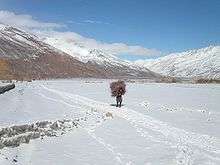Wakhi people
 A Wakhi girl from the village of Zood Khun, Chapursan Valley, Pakistan. | |
| Total population | |
|---|---|
| ~ 50,000–58,000[1][2] | |
| Regions with significant populations | |
| Afghanistan, China, Pakistan, Tajikistan | |
| Languages | |
| Wakhi | |
| Religion | |
| Islam (Ismaili Shia) |
The Wakhi people, or the Khik,[3] are an ethnic group living in adjacent, remote regions of Afghanistan, Tajikistan, Pakistan, and China. They are predominantly centered in Afghanistan's Wakhan Corridor, the northern-most part of Pakistan's Gilgit-Baltistan, the Gorno-Badakhshan region of Tajikistan, and the southwestern region of China's Xinjiang.[4] They are native speakers of Wakhi, an Indo-European language of the Iranian branch.
Name
The Wakhi people refer to themselves as Khik and to their language as Khik zik.[3] The exonym Wakhī, which is given to them by their neighbors, is based on Wux̌, the local name of the region of Wakhan, deriving from *Waxšu, the old name of the Oxus River (Amu Darya), which is a major river formed by the junction of the Vakhsh and Panj rivers on the border between Tajikistan and Afghanistan.[1]
Demographics


Ethnic Wakhi-speakers have a total population of about 50,000–58,000.[1][2] The population is divided between four countries: Afghanistan, Tajikistan, Pakistan, and China's Xinjiang. Due to wars, heavy taxation, and oppression by the local rulers, the Wakhi people have migrated south to form the Wakhi settlements present today in northwestern Pakistan.[5]
In China, the Wakhi people, together with the Sarikoli people, are officially recognized as "Tajiks", with ethnic-minority autonomous status. In Afghanistan, they are officially called "Pamiri". In Tajikistan, they are recognized by the state as "Tajiks", but self-identify as "Pamiri". In Pakistan, they refer to themselves as "Pamiri" or "Gujali".
The Wakhi predominantly adhere to Nizari Ismaili Shia Islam, which is regarded as their ethnic religion, and are followers of the Aga Khan.[3][6][7]
Economy
The Wakhi are primarily nomadic, depending on their herds of yaks and horses.[8] They often have two residences—one for winter and one for summer. Their houses are built of stone and sod.[3]
Cultural preservation
Activists and researchers have been working to preserve and record the language of the Wakhi people, and have developed Wakhi orthographies using the Arabic, Cyrillic, and Latin scripts.[4]
In 1990, the Gojali Wakhis of Pakistan established the "Wakhi Tajik Cultural Association", which aimed to preserve, document, and publish their "local culture". The association introduced a script that was applied into linguistic and literary textbooks, and organized cultural festivals. Radio Pakistan's Radio Gilgit also aired a daily Wakhi-language program named Bam-e Dunya ("Roof of the World").[9][10]
See also
Notes and references
- 1 2 3 "Iranian languages". Encyclopædia Britannica. Retrieved 14 July 2018.
- 1 2 "Wakhi". Ethnologue. Retrieved 14 July 2018.
- 1 2 3 4 Kreutzmann, Hermann (3 September 2003). "Ethnic minorities and marginality in the Pamirian Knot: survival of Wakhi and Kirghiz in a harsh environment and global contexts". The Geographical Journal. Blackwell Publishing. 169: 215–235.
- 1 2 "Wakhi". Endangered Language Alliance. Retrieved 14 July 2018.
- ↑ Shafiq, Nadeem. "The Wakhi Community Settlements in Northern Pakistan". Journal of Political Studies: 1.
The major Wakhi Community settlements in Pakistan are found in Chitral and Gilgit-Baltistan areas. Their ancestors fled to these regions due to a couple of reasons including wars, heavy taxation and oppression by the local rulers and Afghan officials.
- ↑ West, Barbara (2008). Encyclopedia of the Peoples of Asia and Oceania. Facts on File. ISBN 0816071098.
- ↑ Shahrani, M. Nazif Mohib (2002). The Kirghiz and Wakhi of Afghanistan. Seattle: University of Washington Press. p. 216. ISBN 0-295-98262-4.
- ↑ "Khyber Pakhtunkhwa: People and Tribes". Government of the Khyber Pakhtunkhwa. Archived from the original on 16 March 2015.
- ↑ Brower, Barbara; Johnston, Barbara Rose (2016). Disappearing Peoples?: Indigenous Groups and Ethnic Minorities in South and Central Asia. Routledge. p. 184.
- ↑ Windfuhr, Gernot (2013). The Iranian Languages. Routledge. p. 826.
Bibliography
- Felmy, Sabine (1996). The Voice of the Nightingale: A Personal Account of the Wakhi Culture in Hunza. New York: Oxford University Press. ISBN 0-19-577599-6.
- Shahrani, M. Nazif (1979). The Kirghiz and Wakhi of Afghanistan: Adaptation to Closed Frontiers and War. Seattle: University of Washington Press. ISBN 0-295-95669-0. ; 1st paperback edition with new preface and epilogue (2002), ISBN 0-295-98262-4.
External links
- "Photos From Afghanistan: Natural Beauty, Not War". NPR. 29 September 2010. (slideshow)
- "A small village in Gilgit-Baltistan is making big efforts to keep its music alive". Scroll.in. 8 November 2016.